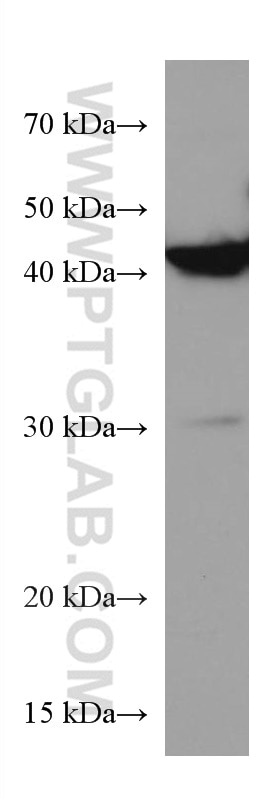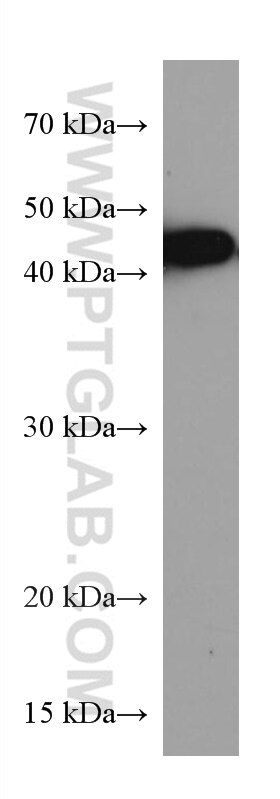BCAT1 Monoklonaler Antikörper
BCAT1 Monoklonal Antikörper für WB, ELISA
Wirt / Isotyp
Maus / IgG1
Getestete Reaktivität
Hausschwein, human
Anwendung
WB, ELISA
Konjugation
Unkonjugiert
CloneNo.
1G3A10
Kat-Nr. : 67084-1-Ig
Synonyme
Geprüfte Anwendungen
| Erfolgreiche Detektion in WB | Ramos-Zellen, Daudi-Zellen, Hausschwein-Hirngewebe |
Empfohlene Verdünnung
| Anwendung | Verdünnung |
|---|---|
| Western Blot (WB) | WB : 1:5000-1:50000 |
| It is recommended that this reagent should be titrated in each testing system to obtain optimal results. | |
| Sample-dependent, check data in validation data gallery | |
Produktinformation
67084-1-Ig bindet in WB, ELISA BCAT1 und zeigt Reaktivität mit Hausschwein, human
| Getestete Reaktivität | Hausschwein, human |
| Wirt / Isotyp | Maus / IgG1 |
| Klonalität | Monoklonal |
| Typ | Antikörper |
| Immunogen | BCAT1 fusion protein Ag28328 |
| Vollständiger Name | branched chain aminotransferase 1, cytosolic |
| Berechnetes Molekulargewicht | 320 aa, 36 kDa |
| Beobachtetes Molekulargewicht | 42-45 kDa |
| GenBank-Zugangsnummer | BC033864 |
| Gene symbol | BCAT1 |
| Gene ID (NCBI) | 586 |
| Konjugation | Unkonjugiert |
| Form | Liquid |
| Reinigungsmethode | Protein-G-Reinigung |
| Lagerungspuffer | PBS with 0.02% sodium azide and 50% glycerol |
| Lagerungsbedingungen | Bei -20℃ lagern. Aliquotieren ist bei -20oC Lagerung nicht notwendig. 20ul Größen enthalten 0,1% BSA. |
Hintergrundinformationen
BCAT1, also named as branched-chain amino acid trasaminase1, is a cytosolic enzyme responsible for the reversible transamination of leucine, isoleucine and valine that catalyzes the transformation of branched-chain L-amino acids (BCAA) into branched-chain a-ketoacids (BCKA), thereby providing macromolecule precursors. It has been reported that BCAT1 is associated with tumor growth and disease progression (PMID:29255149).
Protokolle
| PRODUKTSPEZIFISCHE PROTOKOLLE | |
|---|---|
| WB protocol for BCAT1 antibody 67084-1-Ig | Protokoll herunterladen |
| STANDARD-PROTOKOLLE | |
|---|---|
| Klicken Sie hier, um unsere Standardprotokolle anzuzeigen |




